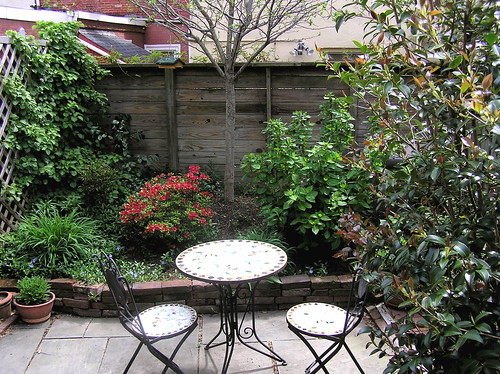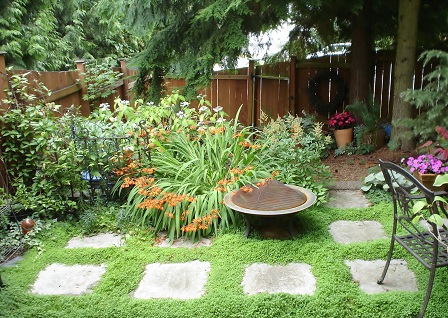It's time to think outside the plot
Moving house is one of the biggest decisions most of us ever make. And for many people the size and position of the garden will play a determining role in choosing your new home.

While designing a small garden certainly brings its challenges, the good news is that small doesn't have to be dull. There is tremendous scope for imagination. The more limited the space the more creative you can be and, indeed, need to be.
The key to success is to plan rigorously and think big. Downsizing doesn't mean that the items you put in your garden have to be smaller: it just means that where you place them has to be carefully considered.

So, ask yourself, will you actually dine outside in the evenings? Are you more likely to sit outside, reading the paper, on a Sunday morning? If you have children (grandchildren) you will probably want to incorporate a play space within the scheme or an area for cooking and entertaining. Or perhaps you are a keen vegetable grower and want to include raised beds for cultivating salads or vegetables. You may prefer a low-maintenance garden that looks good all year round but it not used very much - possibly incorporating some storage and well-chosen evergreen planting.

Whatever your requirements, once you have a wish-list you can start to look at transferring it into the garden. (Usually at this point you will have eliminated the more unrealistic wants: ponds, swimming pools, pergolas and gazebos.) It's all about balance, although it's quite amazing how much can be shoehorned into relatively little space, there does have to be room to move around comfortably.
There are a few clever design tricks that can be used to make the most of any small garden. Large-format hard landscaping is very effective; unified boundaries and simple, clean lines are a must, while grouping planters and pots together creates an appealing and less claustrophobic overall impact.

Further to how you use your small garden is the choice of how it actually looks. The main surface will be the hard landscaping - such as paths, sleepers or rockeries - and this needs to be selected carefully. You want materials that can tolerate the vagaries of the British weather and will look good with as little ongoing maintenance as possible.
Of course, there's only so much you can do to defy nature. But if you select low-maintenance materials, your upkeep will be minimal - making the garden easier to look after and your enjoyment of it greater. Realistically, most stone and wood will gradually collect algae, so maintenance will be required. Accept the need now for some light maintenance - rather than one at all - and you'll achieve a happy balance.
Luckily, many natural stones come in a range of light hues and, since light colours make a small space look much larger, this is probably the way to go. Large-format pavers tend to open the area up, because the eye picks up the stone itself and not the jointing pattern.
 It is a bold decision to opt for a large paver in a small garden, but it always pays off. Limestone or sandstone look fantastic, but these need regular cleaning - so the effort involved has to be offset against the visual effect. Man-made stones are often easier to look after, but don't have the life expectancy of natural stone.
It is a bold decision to opt for a large paver in a small garden, but it always pays off. Limestone or sandstone look fantastic, but these need regular cleaning - so the effort involved has to be offset against the visual effect. Man-made stones are often easier to look after, but don't have the life expectancy of natural stone. And, while many people are phobic about decking, a good hardwood can last for years and has the benefit of slim, long length boards that stretch the eye, making a space feel longer or wider - depending on how it's laid.
If the garden is particularly small, another trick is to rotate the design by 45 degrees. This will make the space feel larger and creates a more interesting area by opening up the eye to the longest boundary along a diagonal line. The garden will feel more dynamic. The same goes for different levels; changes of floor height in a small garden can seem quite daunting - as initially it seems like a way of limiting space. In fact the opposite is true.

A change of level adds interest, defines an area, can make a garden feel bigger and will be more interesting to look at, even when the garden is not in use. Gentle and regular steps of 6" - 7" high are ideal - not too high to be uncomfortable and not too low to be a trip hazard.
Walls and raised beds can then be worked up in multiples of these heights, for example, on a raised bed of 18", steps of around 6" look perfectly in proportion and act as an impromptu seat or ledge on which to sit, garden or relax.
 You may find this hard to picture but try drawing it out on paper. You'll quickly see that this method serves to create larger planting areas in the corners of the garden, which can be populated with evergreen shrubs or climbers to conceal problem areas such as unattractive walls or fences.
You may find this hard to picture but try drawing it out on paper. You'll quickly see that this method serves to create larger planting areas in the corners of the garden, which can be populated with evergreen shrubs or climbers to conceal problem areas such as unattractive walls or fences.From a practical point of view, this is also beneficial to plants, which have room to grow as they would naturally and take less ongoing maintenance. A restricted palette is also good in a small space, as there are fewer distractions to draw the eye.
 In houses where much of the rear elevation is glass (doors/windows), this palette should have a high percentage of evergreen plants - there's no point in getting the design right if the branches are bare for half the year.
In houses where much of the rear elevation is glass (doors/windows), this palette should have a high percentage of evergreen plants - there's no point in getting the design right if the branches are bare for half the year.Downsizing often results in limited access, which can impact on the garden build. If you don't have a side gate, thought must be given to the materials. Everything will have to be carried through the house and, no matter how carefully handled, planting materials are by their nature rather messy. Yes, they can be bagged - but this process will extend the build time and its cost.
The large area of usable ground in a garden is usually the lawn. But in a small plot is it worth the space it takes up? You will need a shed for a mower, which takes up more room? More and more people in small gardens are turning to high quality Astroturf, which provides a dry, usable and pretty much maintenance-free area that can be used all year.
 |
Hellebore orientalis 'Harvington Hybrids' |
Some of this is smoke and mirrors; much is clever compact design, using the tricks described here. The point is, with a bit of magic and know-how, every small space can become a private oasis.
Dos and don't for small gardens:
| Fatsia Japonica |
DON'T be tempted to buy bargains on a whim. Stick to the sizes and shapes you need as these will be key to the use and ultimately the enjoyment of the space.
| Nandia |
DO think big. Super-size items (pots, ornaments, floor surfaces) will draw the eye and create a real wow factor that will take away from the fact that the garden is bijou.
DON'T mix and match. Too many different items will create a confusing overall effect and make the space seem cluttered.
DO incorporate lighting. The space may be small but it will extend the available time you can use the garden.
DO paint walls and fences in light colours, to create a brighter and open effect.
DON'T use materials that contrast with the ones in your home. Use similar flooring, especially if you have glass doors linking the spaces. Your garden will look like an extension of the house - making it seem larger (and the house).
| phormium |
DON'T use dark or clashing colours in quantity A little drama is good but too much can confuse the eye.
 |
| Hosta, having been nibbled by opportunist slug |
(From an article by Kate Gould in the Telegraph this weekend)
also:
Ten great ideas for small gardens (http://au.lifestyle.yahoo.com/better-homes-gardens/gardening/photos/p/9728805/10-great-ideas-for-small-gardens/9728806/)
Pinterest is always good for inspiration, here's an example: http://pinterest.com/maureengilmer/small-budget-gardening/
Plants for small gardens: http://www.gardenersworld.com/plants/features/structural/plants-for-small-gardens/1109.html
and, Small garden design ideas: http://uktv.co.uk/home/item/aid/644917
http://uktv.co.uk/home/item/aid/644198
http://uktv.co.uk/home/item/aid/644196



No comments:
Post a Comment